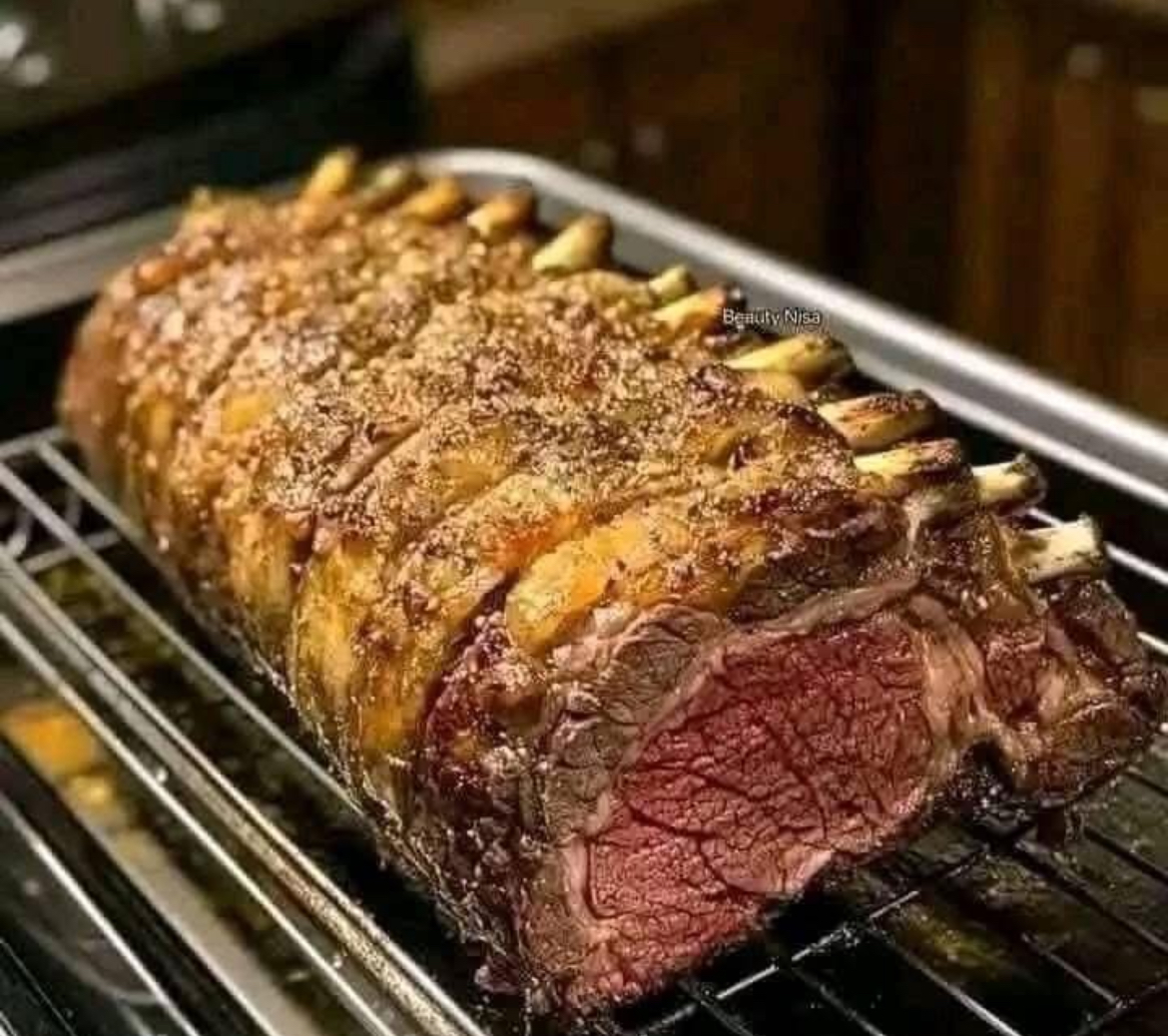### **Prime Rib Recipe for Christmas**
—
#### **Introduction:**
Prime rib, also known as standing rib roast, is a classic centerpiece for festive occasions, especially during Christmas. Its tender, juicy meat and flavorful crust make it a show-stopping dish, perfect for family gatherings or holiday dinners. A prime rib roast offers a blend of elegance and simplicity, making it a favorite for those seeking a delicious and indulgent holiday meal.
—
#### **Origin and Cultural Significance:**
Prime rib has deep roots in Western culinary traditions, particularly in British and American holiday feasts. Known for its rich taste and large size, the roast was historically considered a dish for the upper class, often served during celebrations and festive occasions. Its significance grew during the 19th century when prime cuts of beef began to be more commonly served at formal gatherings. In the United States, prime rib became synonymous with Christmas dinners, embodying both luxury and comfort, making it a staple on many holiday tables.
—
#### **Ingredients Quantity:**
– **Prime Rib Roast (bone-in or boneless):**
1 (4–6 ribs, approximately 8–12 lbs for 6–10 servings)
– **Garlic:**
4–6 cloves, minced
– **Fresh Rosemary:**
2 tablespoons, chopped
– **Fresh Thyme:**
2 tablespoons, chopped
– **Olive Oil:**
2 tablespoons
– **Salt:**
2 tablespoons (or to taste)
– **Freshly Ground Black Pepper:**
1 tablespoon
– **Mustard Powder (optional):**
1 tablespoon
– **Worcestershire Sauce (optional):**
2 tablespoons
– **Beef Broth (for roasting pan, optional):**
1 cup
– **Butter (for finishing):**
2 tablespoons (optional)
—
#### **Optional Additions:**
– **Horseradish Sauce:**
A tangy sauce made from grated horseradish, sour cream, and lemon juice for a flavorful contrast.
– **Roasted Vegetables:**
Carrots, potatoes, and onions, seasoned and roasted alongside the prime rib.
– **Au Jus:**
A rich gravy made from the drippings of the roast.
– **Red Wine Reduction:**
A decadent sauce made with red wine and beef stock to pour over the meat.
—
#### **Tips for Success:**
– **Room Temperature Meat:** Let the prime rib sit at room temperature for 1–2 hours before roasting. This ensures even cooking and helps the meat cook faster.
– **Dry Brine:** For more flavor, rub the prime rib with salt and herbs a day in advance and refrigerate it overnight. This will help season the meat deeply and result in a crispy, flavorful crust.
– **Low and Slow Cooking:** Roast the prime rib at a low temperature (about 225°F) to ensure tender meat. Searing it at the beginning or end of cooking helps develop a flavorful crust.
– **Thermometer Use:** Always use a meat thermometer to achieve the perfect level of doneness. Aim for 120°F for rare, 130°F for medium-rare, and 140°F for medium.
—
#### **Instructions:**
1. **Preparation:**
Preheat your oven to 450°F (230°C). If you’re dry brining, rub the roast with salt and any herbs or spices of your choice a day before and refrigerate. For immediate seasoning, rub olive oil, minced garlic, rosemary, thyme, mustard powder, salt, and pepper all over the prime rib.
2. **Searing (Optional):**
Heat a large skillet over high heat. Sear the prime rib on all sides for 2–3 minutes per side until browned and crusty. This step helps lock in juices and enhances flavor.
3. **Roasting:**
Place the prime rib on a rack in a roasting pan. Optionally, add beef broth to the pan to keep the meat moist during roasting. Roast at 450°F for 15 minutes to develop a crust. Then, reduce the oven temperature to 325°F (160°C) and continue roasting for 2.5 to 3 hours (for medium-rare, check internal temperature starting at 2 hours).
4. **Resting:**
Remove the roast from the oven when it reaches the desired internal temperature (remember, it will continue to cook while resting). Tent the roast with foil and let it rest for 15–20 minutes before slicing.
5. **Serving:**
Slice the prime rib between the bones for bone-in roasts or cut into thick slices for boneless cuts. Serve with roasted vegetables, au jus, or horseradish sauce for extra flavor.
—
#### **Description:**
Prime rib is a beautiful cut of beef from the rib section, offering tender, marbled meat that’s packed with flavor. When cooked properly, it yields a crusty, flavorful exterior while maintaining a juicy, melt-in-your-mouth interior. The recipe provided here highlights the simplicity of the roast while focusing on maximizing flavor through fresh herbs and aromatic garlic. Its indulgent nature makes it an iconic choice for a special holiday feast, particularly at Christmas.
—
#### **Nutritional Information (per 3-ounce serving, approximate):**
– **Calories:** 220 kcal
– **Protein:** 22g
– **Fat:** 14g
– **Saturated Fat:** 6g
– **Cholesterol:** 75mg
– **Sodium:** 450mg
– **Carbohydrates:** 0g
– **Fiber:** 0g
– **Sugar:** 0g
– **Iron:** 10% DV
– **Vitamin B12:** 20% DV
—
#### **Conclusion:**
Prime rib is a luxurious and satisfying dish that is perfect for special occasions like Christmas. Its rich flavor, tender texture, and impressive presentation make it an unforgettable centerpiece for your holiday table. Whether served with classic sides or modern twists, a prime rib roast ensures a meal that will be remembered for years to come.
—
#### **Recommendation:**
If you’re looking to impress guests and indulge in a holiday treat, prime rib is the ideal choice. Ensure you use a high-quality cut of meat and pay attention to cooking temperatures to achieve the perfect result. Pair it with robust wines, mashed potatoes, roasted vegetables, or a simple salad, and your Christmas feast will be both healthful and indulgent.
#### **Embracing Healthful Indulgence:**
While prime rib is rich in flavor and protein, it’s important to balance it with lighter sides like roasted vegetables, green salads, or whole grains to create a more health-conscious meal. By making careful choices with accompaniments, you can savor the luxury of prime rib without compromising your health-conscious goals.
